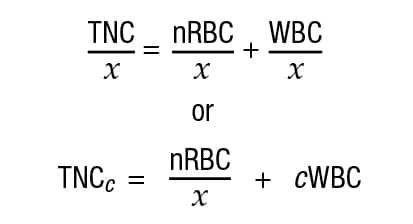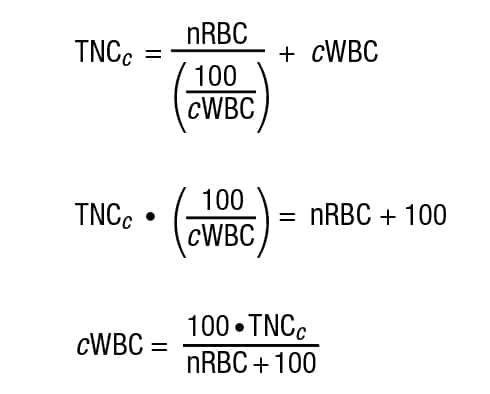For any given blood volume, when counting manually, the relationship between the total nucleated cell (TNC) count, the number of nRBCs (typically reported as the number of nRBCs per 100 leukocytes), and the number of leukocytes (WBC) is given by the following:
![]()
Suppose that, for a given blood sample, x µL are required to garner exactly 100 leukocytes. Thus, when factoring the volume of blood evaluated (i.e. x µL):

Where TNCc is the analyzer-measured WBC concentration and cWBC is the corrected WBC concentration. Thus, substituting and rearranging terms:

While it is certainly possible to apply the correction formula to all cases, the literature suggests that correction be invariably performed whenever nRBC is greater than five per 100 leukocytes (this assertion can also be traced back to the early 1980s,1 again without attribution). Although this cutoff is seemingly arbitrary, the logic behind it is also reasonable when the percent difference between the cWBC and TNC is considered. Above five nRBCs, the percent difference between the cWBC and TNC rises to more than 2.5 percent, which, when the two tails of a distribution are considered, would push an estimated value outside of reasonable confidence interval.
-
-
- Brown B. Hematology: Principles and Procedures, 5th ed. Philadelphia: Lea and Febiger; 1988.
- Green R, Wachsmann-Hogiu S. Development, history, and future of automated cell counters. Clin Lab Med. 2015;35(1):1–10.
-
Etienne Mahe, MD, MSc
Pathologist, Calgary Laboratory Services
Clinical Assistant Professor, Department of Pathology and Laboratory Medicine
University of Calgary, Alberta, Canada
Member, CAP Hematology/Clinical Microscopy Resource Committee
 CAP TODAY Pathology/Laboratory Medicine/Laboratory Management
CAP TODAY Pathology/Laboratory Medicine/Laboratory Management
